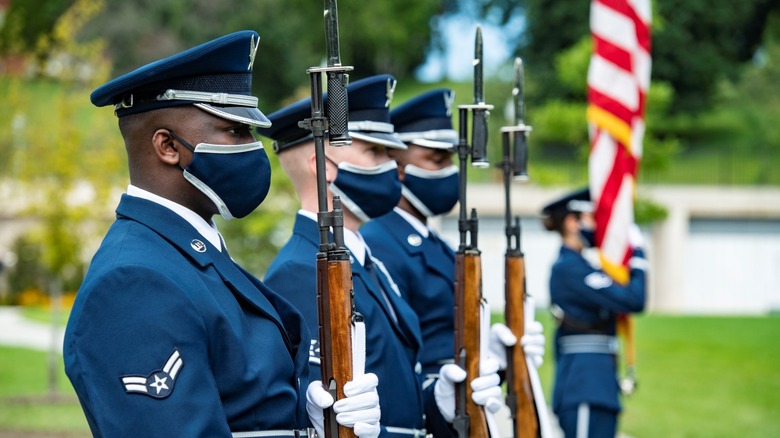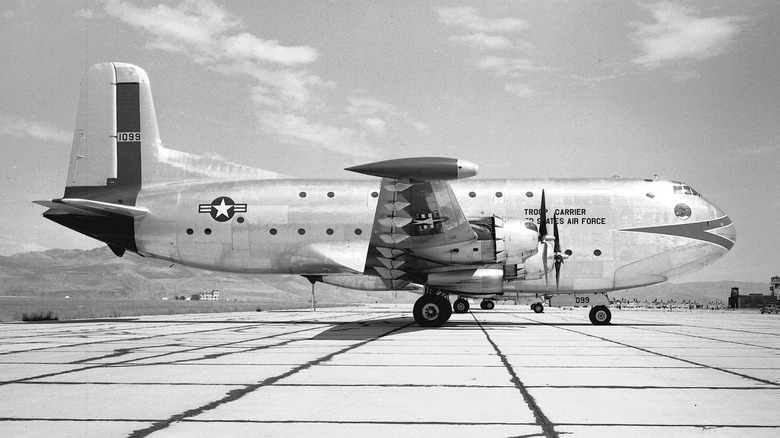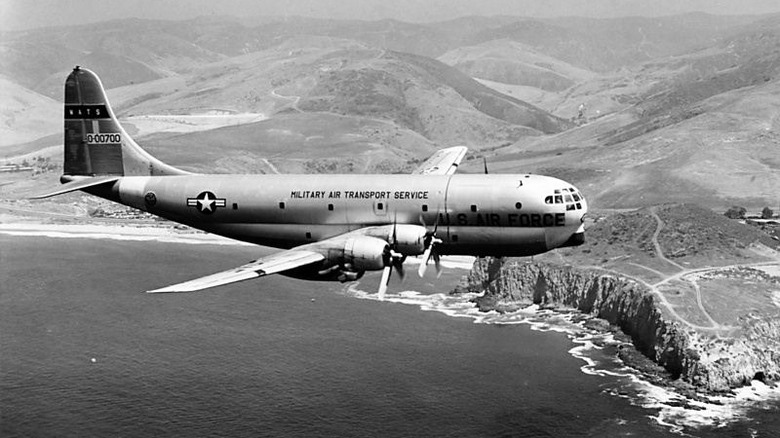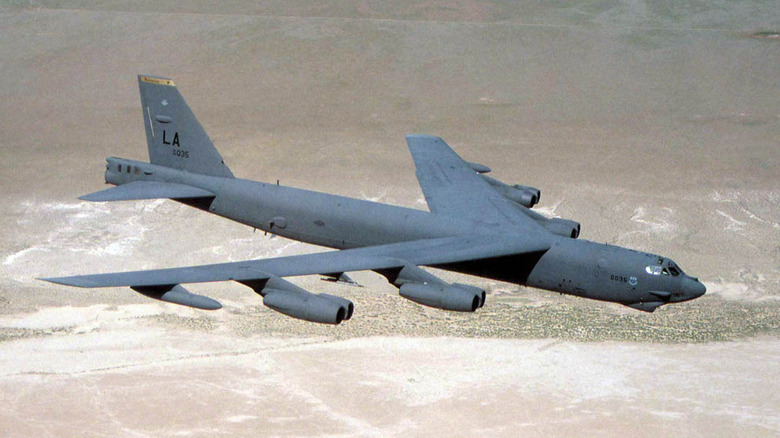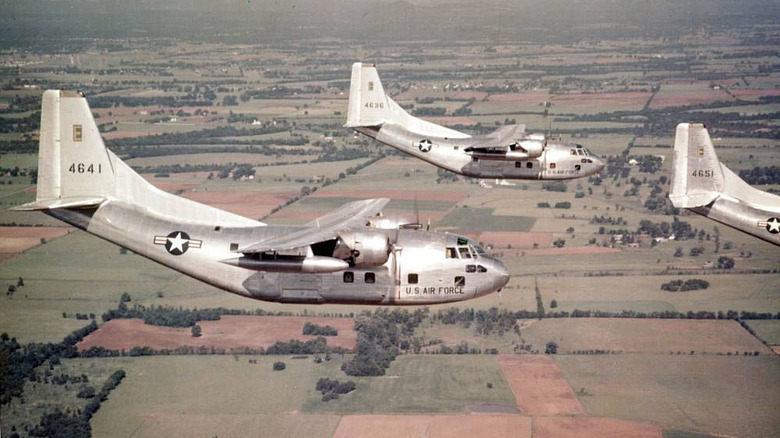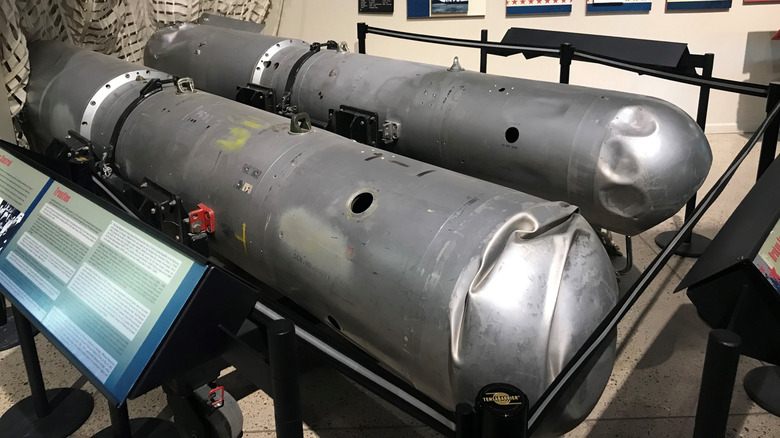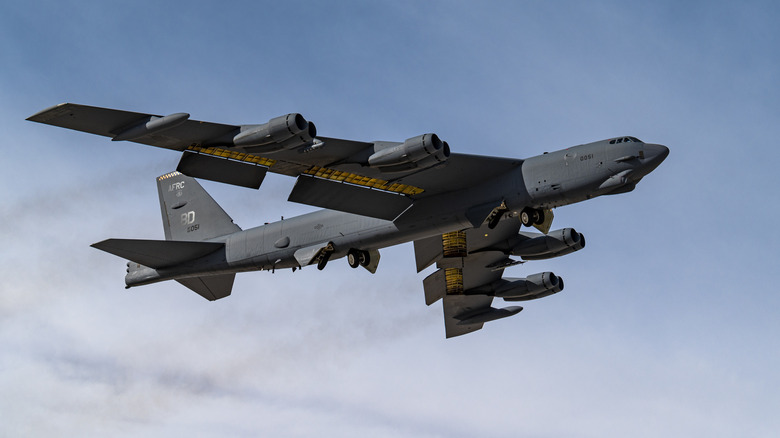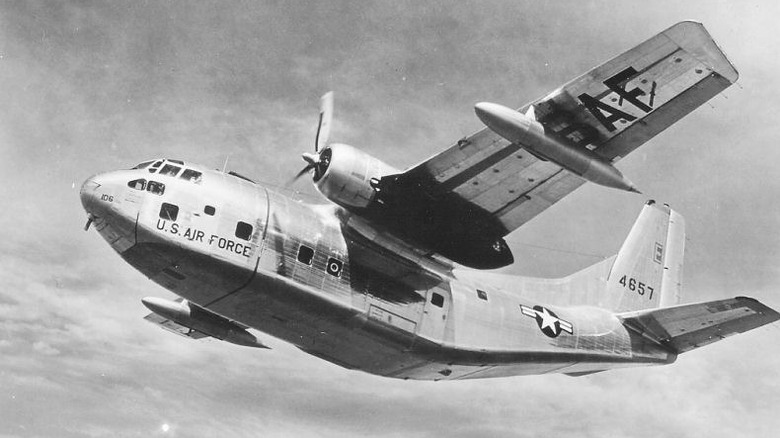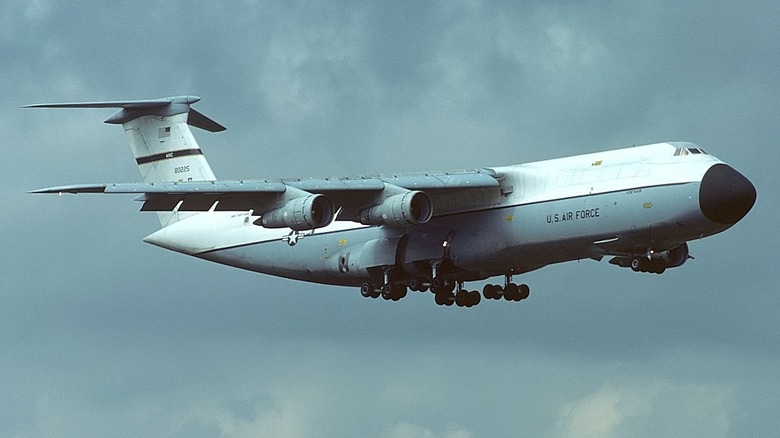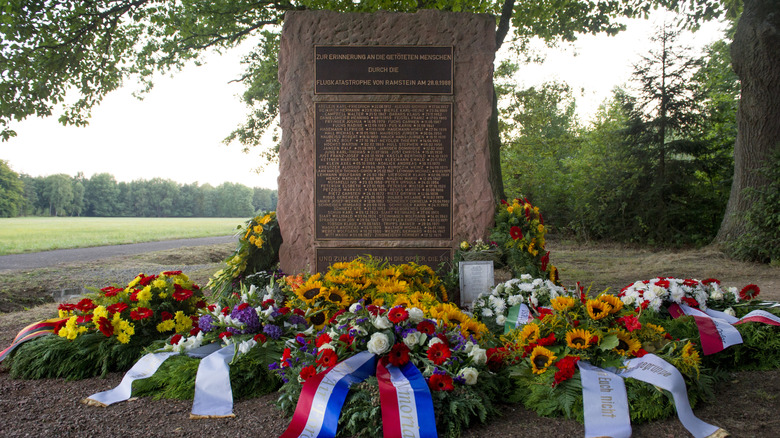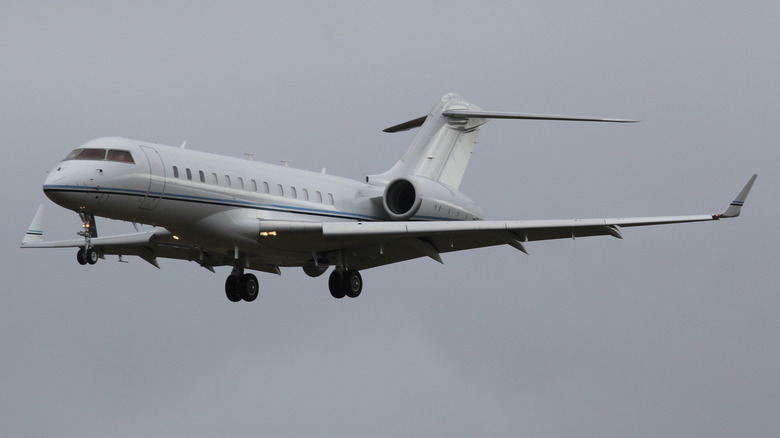10 Of The Worst Accidents Experienced By The United States Air Force
The military is a place where young people can see the world while protecting the United States and its interests from those who would do it harm. It's a dangerous job, especially in times of war, but comes with a sense of national pride and dignity that few other occupations can offer. Tragically, not everybody makes it out of the military alive. Between 1980 and 2022, roughly 1,400 active military personnel die every year, including 250 annually who take their own lives. According to U.S. News, "accidents, illnesses, homicides and self-inflicted wounds account for the vast majority of the death toll over that period."
The United States Air Force – the largest air force in the world – has seen some high-profile accidents over the years. Keep in mind, these are not incidents that occurred during enemy fire in the midst of battle, but accidents during transport, training, and other exercises that killed servicemen. In chronological order from oldest to newest, here are 10 of the worst accidents experienced by the United States Air Force.
1952 Moses Lake C-124 crash
The 1952 Moses Lake C-124 crash was, at the time, the deadliest event in the history of U.S. aviation. The C-124 was part of "Operation: Sleigh Ride," a Korean War plan to bring servicemen home to their families in time for Christmas. The C-124, loaded up with ten crewmembers and 105 passengers, all of whom were servicemen on their way home from the war, was supposed to fly from Larson Air Force Base in Washington state to Kelly Air Force Base in Texas. Unfortunately, the plane's rudder gust locks and flight control elevator had not been properly disengaged by the pilot.
This absent-minded oversight caused the plane's left wing to strike the ground during takeoff, putting the aircraft into a fatal cartwheel. The C-124 was torn apart and exploded, killing 82 of the passengers and five of the crewmen. To this day, it's the single deadliest plane crash in the history of Washington state.
1957 Pacific Ocean Boeing C-97 disappearance
Sometimes, planes go missing and there's no explanation for it. In recent memory, the most notable missing plane was Malaysia Airlines Flight 370, which disappeared with nary a trace in 2014. Some pieces of debris were eventually recovered, but the plane itself, and the 239 people aboard, remain missing, presumed dead.
A similar fate befell the U.S. Air Force in March 1957, when a Boeing C-97C Stratofreighter, carrying 67 people, disappeared en route from Wake Island to Tokyo, Japan. Three civilians were onboard, and the rest were U.S. servicemen. To this day, nobody knows what happened to the C-97C or its passengers; despite a thorough search from both U.S. and Japanese search parties, no trace was ever discovered. No wreckage, no bodies, nothing. Theories abound as to what happened to the plane, but after all these decades, the mystery is likely lost forever, another secret swallowed up by the Pacific Ocean.
1964 Savage Mountain B-52 crash
The Cold War brought the United States and Soviet Union frighteningly close to nuclear conflict. Events like the Cuban Missile Crisis brought the world to the brink of nuclear annihilation, with only luck and diplomacy keeping the East and West from plunging Earth into eternal darkness. Operation Chrome Dome was a U.S. Air Force initiative to keep nuclear-equipped B-52 bombers in the sky at all times, strategically positioned to strike at targets within the Soviet Union at a moment's notice.
On January 13, 1964, a B-52D carrying two nuclear bombs crashed during a winter storm in Maryland, on its way to Georgia from Massachusetts after a Chrome Dome deployment. The vertical stabilizer broke off as the bomber rapidly changed altitude in an effort to avoid turbulance caused by the storm. The bomber went down in the snow. Of the five crewmembers, all but one ejected from the plane. The remaining crewman died in the crash. Of the initial survivors, two died alone in the snow after trying to find help or shelter; they couldn't get far due to injuries and died in the bitter cold.
There were only two survivors — the pilot, who was lucky enough to land safely and find help, and the co-pilot, who set up camp where he landed and waited for help, which arrived after 36 hours.
1965 Fairchild C-123B crash
On December 11, 1965, 85 people were killed in a Fairchild C-123B plane crash in the Phú Yên Province of Vietnam. They weren't shot down by the enemy, but died in a tragic accident.
The C-123B was carrying four American crewmen and 81 South Vietnamese paratroopers on their way from Pleiku to Tuy Hoa Air Base. Unfortunately, visibility was extremely low due to rainfall and the plane was without a navigator. With visibility virtually non-existent, the plane was unaware of its critically low altitude and struck some trees on a ridge line during its descent, causing the pilot to lose control and sending the C-123B into a flat spin. The plane crashed in Viet Cong territory. All onboard were killed in the crash, but American forces were unable to reach the wreckage for two weeks due to the heavy enemy presence.
1966 Palomares incident
The 1966 Palomares incident is among the worst nuclear accidents. It resulted in the deaths of seven people and an international incident that put political pressure on Operation Chrome Dome, questioning whether it was absolutely necessary for the United States to maintain an airborne nuclear presence over Europe.
On January 17, 1966, a B-52 bomber was attempting a mid-air refuel at 31,000 feet when it crashed into the fueling tanker. The tanker was completely destroyed, killing all four crew members aboard. Three of the seven crewmembers of the B-52 also died. But what made this an international incident was the fate of the four bombs onboard the B-52. Three fell on Spanish land, whereupon their conventional explosives detonated. While a nuclear explosion did not occur, radioactive material was still spread over a large area. The fourth bomb went missing in the Mediterranean Sea, prompting an 80-day search.
Though the bomb was eventually recovered, the political and environmental damage was done. Spain banned the United States from flying nuclear weapons over Spanish territory, and parts of the Andalusia region of Spain remain radioactive to this day.
1968 Thule Air Base B-52 crash
The 1968 Thule Air Base crash led directly to the dissolution of the Chrome Dome program. On January 21, 1968, a B-52 bomber, callsign "Hobo 28," had an unexpected cabin fire hot air from the engines, routed through the cockpit's heating system, ignited foam cushions beneath the navigator's seat. Despite efforts from the crew, the fire could not be extinguished, and they were forced to evacuate. Of the seven crew members, six got out safely and lived to tell the tale, but the co-pilot, Leonard Svitenko, hit his head and died when he tried to exit the plane via a hatch on the lower deck.
When the plane crashed, in North Star Bay in western Greenland, the craft's standard ordnance exploded. While the nuclear bombs did not detonate, nuclear material was spread over the area, leading to an extensive cleanup operation, called Project Crested Ice. As a result of the crash, as well as the aforementioned entries on this list, Operation Chrome Dome was suspended in 1968, although the widespread adoption of intercontinental ballistic missiles, or ICBMs, ultimately made the use of nuclear bombers unnecessary.
1970 Fairchild C-123 Provider crash
The Fairchild C-123K may not be among the Vietnam War's most notable aircraft in performance terms, but it does have a dubious safety record. Like the aforementioned 1965 Fairchild crash, the 1970 disaster was a result of low visibility and caused massive loss of life while transporting dozens of South Vietnamese soldiers. In this case, six crew members and 73 Vietnamese passengers were killed.
On November 27, 1970, the transport was on its way to Nha Trang Air Base from Saigon when disaster struck. In circumstances eerily similar to the aforementioned 1965 incident involving an earlier generation of the same plane, visibility was low due to poor weather, and as a result, the C-123K struck some trees on a ridge, causing the pilot to lose control and crash, killing everyone onboard. The wreckage was found nine days later.
Two days after the crash, on November 29, 1970, another C-123K went down when it struck terrain hidden by extensive cloud coverage. Only two of the 44 occupants survived the resulting crash. Combined, these two accidents killed 121 people.
1975 Tân Sơn Nhứt C-5 accident
Operation Babylift was an effort by the U.S. Air Force to bring orphaned Vietnamese children to the United States and other Western countries. Though not without controversy, it was seen as a way to save orphans from the wrath of a unified communist Vietnam after America's failure in the closing days of the Vietnam War.
On April 4, 1975, a Lockheed C-5 jet carrying 314 people, suffered explosive decompression shortly after takeoff. The locks on the rear loading ramp, which had been improperly installed and did not engage properly, came loose, forcing the cargo door open. The resulting explosive decompression caused catastrophic failures all over the plane. Captain Dennis Traynor and co-pilot, Captain Tilford Harp were forced to crash land the plane in a rice paddy, where the plane hit a dike and broke into four pieces. Of the 314 people on the plane, 138 were killed, many of whom were children.
Despite the numerous casualties, the actions of Traynor, Harp, and the other crew members averted even larger loss of life. Traynor and Harp were awarded the Air Force Cross for extraordinary valor, due to their quick reactions and good judgment during a moment of crisis. It was a tragic day, but it could have been much worse.
1988 Ramstein air show disaster
Air shows are spectacular displays of piloting skill where planes perform acrobatic aerial maneuvers to the delight of the spectators watching on the ground below. However, risky aerial moves can sometimes go wrong, and that's exactly what happened at the West German Ramstein Air Base on August 28, 1988, resulting in the single deadliest air show event in the history of the United States Air Force.
During a low-altitude crossing pattern of Italian Aermacchi MB-339PAN jets, one pilot finished his maneuver too early and accidentally collided with another. Three of the air show planes crashed, killing three pilots. One of them was able to eject from his aircraft, but since the show was so low-altitude, he hit the ground before his parachute could be deployed. Flames and debris from the broken planes killed 67 people on the ground and injured hundreds more. In total, the 70 fatalities included four Americans, three Italians, one French, one Dutch, and 61 Germans.
2020 United States Air Force E-11A crash
The 2020 E-11 crash is a solemn reminder that tragedy can strike anyone, anywhere, at anytime. On January 27, 2020, Lieutenant Colonel Paul K. Voss and Captain Ryan S. Phaneuf were killed when their E-11A went down in the Ghazi province of Afghanistan. At the time, there was much confusion and misinformation regarding the crash, with the Taliban claiming to have shot it down and Russo-Iranian propaganda suggesting that CIA boss Michael D'Andrea was among those killed in the crash. Both claims were eventually debunked. D'Andrea is still very much alive, and the plane wasn't shot down.
The E-11 crashed as a result of pilot error and a faulty engine part. According to the official investigation, there was a broken turbine blade in the left engine. Unfortunately, the pilot misidentified which engine was broken, and turned off the right engine instead, leaving the plane entirely without power. During the plane's rapid descent, Voss and Phaneuf attempted an emergency landing, but failed. The plane burst into flames as it crash-landed, killing the two pilots as well as two local Afghan nationals on the ground.
